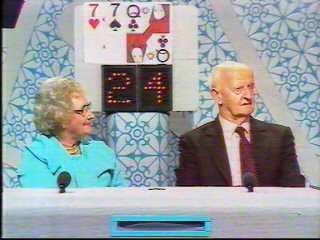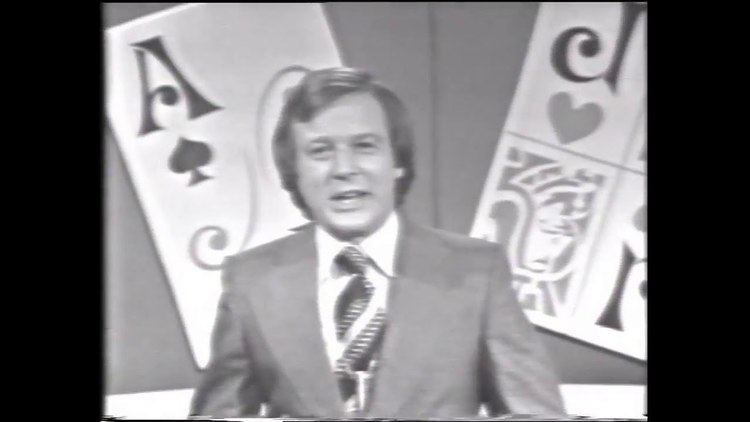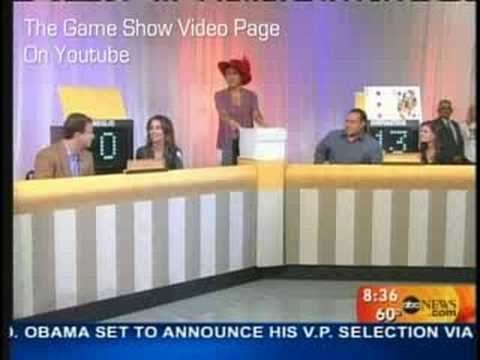5.6 /10 1 Votes
5.3/10 TV Directed by Jerome Shaw Country of origin United States Final episode date 27 November 1981 Genre Game show | 5.8/10 IMDb First episode date 4 September 1972 Language English | |||||||||||||||||||||||||||||||||
 | ||||||||||||||||||||||||||||||||||
Similar Game show, High Rollers, Headline Chasers, Battlestars, The Magnificent Marble M | ||||||||||||||||||||||||||||||||||
Gambit full rare episode
Gambit is an American television game show based on the card game blackjack, created by Heatter-Quigley Productions. The show originally ran on CBS from September 4, 1972, to December 10, 1976, and was recorded at CBS Television City in Studios 31, 33, 41, and 43. On October 27, 1980, NBC revived the show as Las Vegas Gambit, as a replacement for The David Letterman Show, and kept it on its schedule until November 27, 1981. As the title implied, this edition of Gambit was recorded in Las Vegas with the Tropicana Las Vegas, which had previously hosted Dealer's Choice and later hosted Let's Make a Deal, serving as the show's base. Both versions were hosted by Wink Martindale and announced by Kenny Williams. Elaine Stewart was the card dealer for the CBS version, while Beverly Mauldin filled this role for the first half of Las Vegas Gambit, and was later replaced by Lee Menning.
Contents
- Gambit full rare episode
- Gambit part 1
- Main game
- Gambit Board
- Gambit Galaxy
- CBS 197276
- NBC 198081 Las Vegas Gambit
- Personnel
- Catch 21
- Australia
- United Kingdom
- Episode status
- References

Another Merrill Heatter-produced, blackjack-based quiz show, Catch 21, began airing on GSN in 2008. This show shares some similarities with Gambit, but with several noticeable differences.

Gambit part 1
Main game

The object of the main game was that of blackjack: come as close to 21 as possible without going over (or busting). As in blackjack, the cards 2 through 10 were worth their face value, face cards (Kings, Queens, Jacks) counted as 10, and Aces could count as either 1 or 11.

Martindale asked a series of questions, usually multiple-choice or true-false, to two married couples. The first couple who buzzed in and correctly answered the question won control of the top card from a deck of oversized, regulation playing cards. An incorrect answer awarded control of the card to the couple's opponents. The first card was shown before the first question, but cards thereafter were presented face down.

Once a couple gained control of a card, they had the option of adding it to their own hand or passing it to their opponents. Each face-down card was turned up once the couple in control decided who should receive it. After a couple received any card (either by choice or by having it passed to them), they could elect to freeze, preventing them from receiving any more cards. Freezing was not permitted when the two couples were tied. If one couple froze, the other continued answering questions and received a card after each one.
A couple could win the game in one of four ways:

Each game was worth $100. The first team to win two out of three games won the match and advanced to the bonus round.
Gambit Board
For the entire original series and the first half of Las Vegas Gambit, the winning couple played the Gambit Bonus Board. They faced a large game board with 21 numbered cards (18 numbered video screens on Las Vegas Gambit), each concealing a prize. After selecting a number, the couple received the prize behind it and a card was added to their hand from the top of the deck.
The couple could end the bonus game by doing any of the following:
Throughout the CBS version, returning champions continued until winning a grand total of $25,000, relinquishing any winnings over that amount.
From 1972 to 1975, the show featured an annual promotion in which the first couple to get a two-card 21 (an Ace and a face card/10) in the bonus round won either $200 a week for a year (totaling $10,400) or a flat $10,000, depending on the year.
Special awards were occasionally hidden among the numbers, including:
Gambit Galaxy
For the second half of the NBC version, the Gambit Board was replaced by a renamed Big Numbers bonus round from the Heatter-Quigley show High Rollers. In this round, called the Gambit Galaxy, the couple was presented with a pair of dice and was required to remove the numbers 1 through 9 from a board in front of them. On each turn, the couple rolled the dice and chose numbers to remove that added up to the total shown. (For example, if they rolled an 8, they could remove the 8 alone; 1 and 7; 2 and 6; 3 and 5; 1, 2, and 5; or 1, 3, and 4.) They won $100 for each number removed, and if they managed to knock all nine numbers off the board they won $5,000 in cash and a prize package, which usually included at least $5,000 in prizes to start and kept accumulating until a couple won it.
The round ended if the couple made a "bad roll" - a total that could not be achieved using the numbers still on the board. Rolling doubles awarded an insurance marker; if a bad roll came up, the couple could turn in the marker and continue playing.
CBS, 1972–76
CBS originally put Gambit on at 11 a.m/10 Central where it defeated NBC's Sale of the Century. It also easily beat Alex Trebek's American debut program, The Wizard of Odds, which NBC began in July 1973. On April 1, 1974 (the same day Now You See It with Jack Narz premiered), CBS moved the show ahead a half-hour to 10:30/9:30, where it faced NBC's aging quiz Jeopardy!, just over a full decade before Trebek would commence hosting a revival of that show himself. NBC moved Jeopardy! to the afternoons on July 1 and placed one of the many Bill Cullen-Bob Stewart collaborations, Winning Streak, in the slot. That show's weakness made late 1974 the high point of Gambit's original daytime run, at least in the Nielsen ratings.
On January 6, 1975, NBC replaced Winning Streak with Wheel of Fortune, which took a chunk out of Gambit's audience. On the same day, NBC expanded the soap opera Another World to sixty minutes, and the impact it had on the ratings of The Price is Right, which aired at 3:00 pm, forced CBS to shuffle its schedule again on August 18, 1975 and move Price back to the morning schedule, which it had left in 1973. Gambit moved back to 11:00 am, bumping Tattletales back to the afternoon after two months, and remained there until its cancellation. At that slot, Gambit initially had to go against its sister Heatter-Quigley show High Rollers, also hosted by Alex Trebek. However, NBC decided to air a sixty-minute edition of Wheel beginning on December 1, with the second half competing with Gambit. Furthermore, NBC left Wheel at 11:00 am when the experiment ended seven weeks later in January 1976 and it continued to eat away at Gambit in the ratings. The network canceled the four-year-old game two weeks before Christmas 1976 and replaced it with Goodson-Todman's Double Dare, with Trebek taking the hosting position after High Rollers came to an end on June 11, 1976.
After its cancellation, repeats of Gambit were later seen on KHJ-TV Channel 9 (now KCAL-TV) in Los Angeles, starting in fall 1977 and running until spring 1978.
NBC, 1980–81 (Las Vegas Gambit)
Gambit returned on October 27, 1980 as one of two replacements for the short-lived The David Letterman Show (the other was Goodson-Todman's Blockbusters). Stan Worth composed the theme for this version. with Beverly Malden serving as card dealer before she was replaced by Lee Menning. Producer Robert Noah, director Jerome Shaw, and announcer Kenny Williams carried over from the original.
Despite limited competition in the form of sitcom reruns on CBS and local programming on ABC affiliates, the revival failed to draw the ratings of its predecessor and was cancelled after just over a year.
Personnel
Both the original version and Las Vegas Gambit were hosted by Wink Martindale, with Kenny Williams, announcer of many other Heatter-Quigley shows, as announcer. Jerome Shaw was the director of both versions, and Robert Noah the producer. Elaine Stewart was the card dealer on the original version, while Beverly Mauldin served in this role on early episodes of Las Vegas Gambit before being replaced by Lee Menning. Mort Garson composed the original version's theme, and Stan Worth composed the theme to Las Vegas Gambit.
Catch 21
Gambit creator Merrill Heatter developed a similar show, Catch 21, which premiered on GSN July 21, 2008 with Alfonso Ribeiro as host and Mikki Padilla as dealer.
Australia
In Australia, a version produced for the Nine Network briefly aired in 1974. The host was Peter Hitchener and the dealer was Ros Wood. It was produced by the Reg Grundy Organisation.
United Kingdom
A British version of the show was produced by Anglia Television for ITV, notable for its opening title sequence featuring various casino equipment including playing cards, casino chips, a roulette wheel and a fruit machine. It started in 1975 as a programme shown in the Anglia region only, but became a networked show in 1978 and ran until 1985. The original host was Fred Dinenage, later succeeded by comedian Tom O'Connor, and Michelle Lambourne was the card dealer. The programme returned to ITV for a 12-week run in 1997 and was hosted by British comedian Gary T Thompson.
In the ITV version, each game was worth £20. The Gambit Jackpot started at £200 and increased by £50 until won or until it hit £500. Also, no cars were originally offered in the endgame (from 1981 onwards, they did offer a car as one of the star prizes). The cards used on this version had the same design as the U.S. version.
The 1990s revival utilized the same format as the 1990 pilot taped in America. Two contestants competed for a prize and the right to return the following Sunday against a new opponent. Each question would feature two answers displayed on the screen and the player who buzzed in must guess which answer, both, or neither of the answers applied to the question.
Episode status
Five episodes of the CBS version from 1973 are held by the UCLA Film and Television Archive. The pilot for an unsold 1990 revival, hosted by Bob Eubanks, is also present within the same collection.
